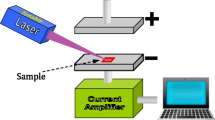Summary
The limits of identification are given for the spectrochemical determination by the cathode excitation technique, of the volatile, medium and heavy volatile elements in glass-making sands. There is a relationship between the lowest limit of detection of the matrix elements and the different buffers added at various concentrations. This is because variations in the intensities of the lines of the constituent elements on the addition of buffers appear to be closely connected not only with the initial ionisation potential of the constituent elements of the matrix, but to a greater extent with the chemical nature of the newly formed species within the crater and their rate of volatility at a given temperature when the arc is struck.
Zusammenfassung
Die Grenzen der spektrochemischen Bestimmbarkeit bei kathodischer Anregung der flüchtigen, mittel- und schwerflüchtigen Elemente in Sanden zur Glasfabrikation wurden angegeben. Es besteht eine Beziehung zwischen der Nachweisgrenze der Matrixelemente und den in verschiedenen Konzentrationen zugesetzten spektrochemischen Puffern. Die Linienintensität der vorhandenen Elemente hängt nämlich nicht nur sehr stark vom anfänglichen Ionisierungspotential der Matrixelemente, sondern noch mehr von der chemischen Natur der neugebildeten Substanzen im Krater und deren Flüchtigkeit bei gegebener Bogentemperatur ab.
Similar content being viewed by others
Literatur
L. H. Ahrens, Quantitative Spectrochemical Analysis of Silicates. London: Pergamon. 1954.
L. H. Ahrens, I. S. African Chem. Inst.27, No. 2, p. 28 (1944).
L. H. Ahrens, Spectrochim. Acta4, 302 (1951).
P. W. J. M. Bouman, Theory of Spectrochemical Excitation. London: Hilger and Watts. 1966.
H. Kaiser, Z. analyt. Chem.209, I (1965).
D. J. Hobbs andD. M. Smith, Can. Spectry11, 5 (1966).
R. O. Scott, J. Soc. Chem. Ind.64 (1945).
W. Ward andF. Hartley, J. Soc. Glass Tech.37, 113 (1953).
W. Ward andD. D. Innes, Trans. Soc. Glass Tech.39, 156 (1955).
C. E. Harvey, A Method of Semi-Quantitative Spectrographic Analysis. Glendale, California: Applied Research Laboratories. 1947. p. 171.
O. P. Semenova andM. A. Levchenko, Opt. i Spektroskopiya13, 609 (1962); Opt. Spectry. (USSR)13, 347 (1962).
G. Holdt, Appl. Spectry.16, 96 (1962).
A. N. Zaidel, G. M. Malyshev, andE. Ya. Schreider, Opt. i Spektroskopiya17, 129 (1964); Opt. Spectry. (USSR)17, 65 (1964).
R. L. Mitchell, Soil Crop Sci. Soc. Florida Proc.15, 12 (1955); Commonwealth Bur. Soil. Sci. Tech. Commun. No. 44, pp. 77–93 (1948).
Author information
Authors and Affiliations
Rights and permissions
About this article
Cite this article
Hanna, Z.G., Abdellha, M.H. A study of the influence of buffers on sensitivity in the spectrochemical analysis of glass-making sands by the cathode excitation method. Mikrochim Acta 56, 1244–1253 (1968). https://doi.org/10.1007/BF01224427
Received:
Issue Date:
DOI: https://doi.org/10.1007/BF01224427




